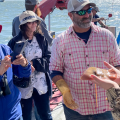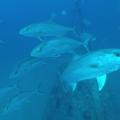Manipulating Pond Balance
Manipulating Pond Balance
Pond balance means that predator (bass) and prey (bream) are both reproducing and growing at a desirable rate (to the pond owner). Bluegill make enough babies to keep bass full and growing well, and bass eat enough bluegill babies so that the ones that survive have lots of food to grow larger and reproduce more.
If there are too many bass, there are not enough bream to eat and bass growth is poor, yet the few surviving bream eat well and get big. If there are too few bass, they cannot eat enough baby bream, so bream overpopulate and stay small, yet the few bass can get big. It is a dynamic spectrum, with big bream (panel 1 below) on one side and big bass (panel 3) on the other side. Most people like to be somewhere in the middle (panel 2), but each end has its benefits depending on your fishing preferences.

Panel 1: Bass-crowded pond. If having large bluegill and high catch rates of aggressive small bass is your objective, a bass-crowded pond is the desirable situation. However, if you want large bass, the following recommendations may help you improve bass growth and size. In one year, remove 35 pounds of bass that are fewer than 13 inches long per acre. In a fertilized pond, remove 50 pounds of bass fewer than 13 inches. Return all larger bass to the pond. Reassess the pond the following year, and repeat intensive bass harvest as necessary. When annual balance checks indicate the pond is once again in balance, revert to harvesting bass and bream at the normal recommended rates described previously.
Panel 2: Balanced pond. This is the best situation for good fishing of both species. You should catch bass and bream of all sizes, with moderate catch rates. If this is your objective, maintain harvest rates (15 pounds of small bass per acre each year; 30 pounds for fertile ponds) and reassess next year.
Panel 3: Bream-crowded ponds. If aquatic weeds are a problem, eliminate the weeds first. Remove as many intermediate bluegill as possible using angling, and consider using a piscicide application along shorelines in the early fall. After bream removal, stock 35 adult (10- to 12-inch) largemouth bass per acre to eat small bream, and draw the pond down in winter to concentrate the bass with the bream. Reassess the following year.
News
BILOXI, Miss. -- The Southeast has some of the most commercially and recreationally valuable fisheries in the United States.
Fisheries experts at Mississippi State University and other research institutions are conducting an $11.7 million study of the greater amberjack, an important recreational and commercial species in the South Atlantic and Gulf of Mexico that is threatened by overfishing.
Grandpa cast the jig and cork to the center of the pond and handed it to Lucy. “Now, start reeling in slowly,” he said.




